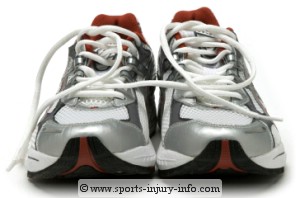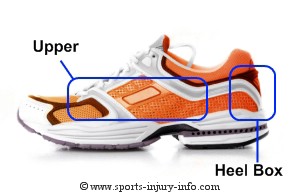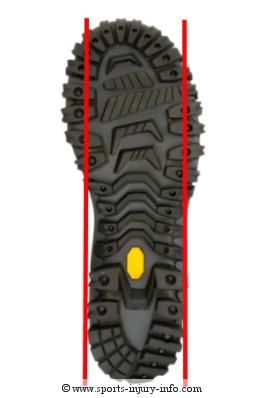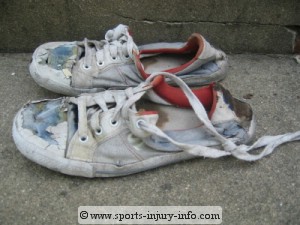Choosing Athletic Shoes

Below you will find some of the things you need to consider when choosing shoes for your sport.
Style Isn't Everything
Just about every day, someone asks me about their shoes. Questions vary from sport to sport, but the fact remains that the majority of people choose athletic shoes based on brand names and styles, rather than what is best for their own feet.I know that it can be hard to pass up those awesome looking shoes that match your uniform perfectly, but in the long run, the most important thing is that the shoe serves its function...to support and protect your feet. So, lets take a closer look at what makes a good athletic shoe.
The Heel Box
When I explain shoes to my patients, I always start with the heel box. This is where most people are similiar in their needs. A sturdy heel box is essential to help control your rear-foot during athletic activities. The heel box is essentially the back third of the shoe, that surrounds your heel. Most athletic shoes have a heel box made up of leather, and some type of plastic or rubber re-inforcement.
However, not all athletic shoes are created equal. To test the heel box, try bending it over, or squeezing it in, and see how much resistance you encounter. If you can easily fold over the heel box, then chances are you will not get much support.
The Upper
This is the area where most people make the mistake that causes injury. The "Upper" is the portion of the shoe that surrounds the foot. It is the upper portion of the shoe, from the heel box to the toe box. Uppers can be fashioned from all kinds of different materials, from mesh to leather, and other types of fabrics. Depending on your foot type, you may need more or less support from the upper.This portion of the shoe helps to control the mid and forefoot. Too
much motion in these areas will allow for excessive stress through the
meta-tarsals and tarsals, and can result in stress fractures,
tendonitis, and other problems.
To
determine what type of foot you
have, grab ahold of your foot with both hands, and move it around. Try
moving individual bones around...do you find lots of motion, with
little resistance, or is your foot very rigid, with little movement.
You don't have to be an expert to tell if you have a flexible or rigid
foot. Your athletic shoe should be opposite of your foot type. For
rigid feet, you can get by with mesh or other light materials for the
upper, as you need less support for your foot. For a flexible foot, you
should lean more toward a rigid upper, that will control excessive
motion and reduce stress.
The Arch

When choosing shoes, look closely at the sole of the shoe. A good arch support will be evident by the shape of the shoe. Notice the outline of the sole. There should be a minimal amount of change in width between the toe and the heel. The wider the athletic shoe is at the middle (where your arch is), the more surface area there is to support your foot.
Avoid shoes that start out wide at the toe, narrow way down in the middle, and then flare out again at the heel. (no offense to Nike, but they are notorious for very narrow arches in their shoes)
Change is Good
Even the perfect shoe will wear out over time. I have seen quite a few injuries due to old or worn out shoes. Just like any other equipment, you should monitor your shoes, and replace them when they wear out. If you are a runner, monitor your mileage, and replace them as appropriate.
How do you know when to buy new shoes? Well, holes, or pieces falling off are generally good indicators...But if it isn't that obvious, look for all of the qualities that you used to choose the athletic shoe in the first place. Is the heel box still sturdy? Is the upper as rigid as it needs to be to control your foot? Is the arch still in good shape, or have you worn down one side of the sole?
Answer these questions, and inspect your shoes often to keep them protecting your feet.








